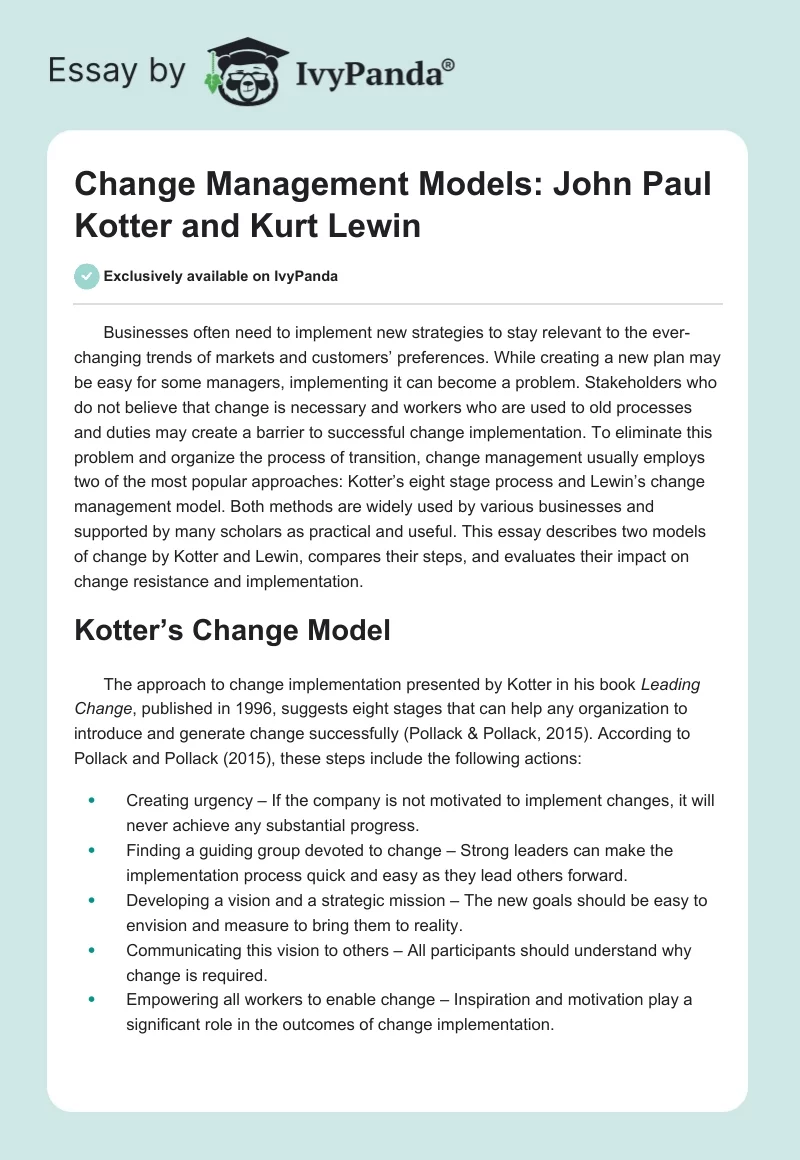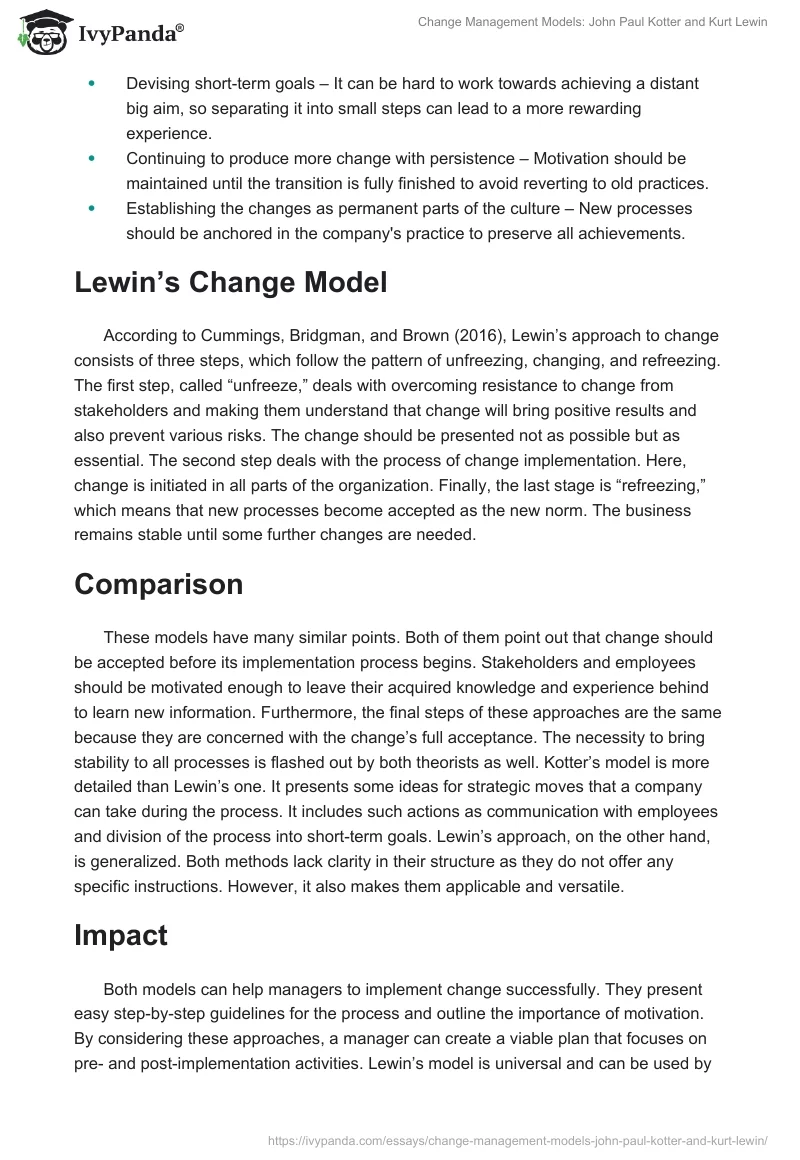Businesses often need to implement new strategies to stay relevant to the ever-changing trends of markets and customers’ preferences. While creating a new plan may be easy for some managers, implementing it can become a problem. Stakeholders who do not believe that change is necessary and workers who are used to old processes and duties may create a barrier to successful change implementation. To eliminate this problem and organize the process of transition, change management usually employs two of the most popular approaches: Kotter’s eight stage process and Lewin’s change management model. Both methods are widely used by various businesses and supported by many scholars as practical and useful. This essay describes two models of change by Kotter and Lewin, compares their steps, and evaluates their impact on change resistance and implementation.
Kotter’s Change Model
The approach to change implementation presented by Kotter in his book Leading Change, published in 1996, suggests eight stages that can help any organization to introduce and generate change successfully (Pollack & Pollack, 2015). According to Pollack and Pollack (2015), these steps include the following actions:
- Creating urgency – If the company is not motivated to implement changes, it will never achieve any substantial progress.
- Finding a guiding group devoted to change – Strong leaders can make the implementation process quick and easy as they lead others forward.
- Developing a vision and a strategic mission – The new goals should be easy to envision and measure to bring them to reality.
- Communicating this vision to others – All participants should understand why change is required.
- Empowering all workers to enable change – Inspiration and motivation play a significant role in the outcomes of change implementation.
- Devising short-term goals – It can be hard to work towards achieving a distant big aim, so separating it into small steps can lead to a more rewarding experience.
- Continuing to produce more change with persistence – Motivation should be maintained until the transition is fully finished to avoid reverting to old practices.
- Establishing the changes as permanent parts of the culture – New processes should be anchored in the company’s practice to preserve all achievements.
Lewin’s Change Model
According to Cummings, Bridgman, and Brown (2016), Lewin’s approach to change consists of three steps, which follow the pattern of unfreezing, changing, and refreezing. The first step, called “unfreeze,” deals with overcoming resistance to change from stakeholders and making them understand that change will bring positive results and also prevent various risks. The change should be presented not as possible but as essential. The second step deals with the process of change implementation. Here, change is initiated in all parts of the organization. Finally, the last stage is “refreezing,” which means that new processes become accepted as the new norm. The business remains stable until some further changes are needed.
Comparison
These models have many similar points. Both of them point out that change should be accepted before its implementation process begins. Stakeholders and employees should be motivated enough to leave their acquired knowledge and experience behind to learn new information. Furthermore, the final steps of these approaches are the same because they are concerned with the change’s full acceptance. The necessity to bring stability to all processes is flashed out by both theorists as well. Kotter’s model is more detailed than Lewin’s one. It presents some ideas for strategic moves that a company can take during the process. It includes such actions as communication with employees and division of the process into short-term goals. Lewin’s approach, on the other hand, is generalized. Both methods lack clarity in their structure as they do not offer any specific instructions. However, it also makes them applicable and versatile.
Impact
Both models can help managers to implement change successfully. They present easy step-by-step guidelines for the process and outline the importance of motivation. By considering these approaches, a manager can create a viable plan that focuses on pre- and post-implementation activities. Lewin’s model is universal and can be used by any organization. It is also easy to explain, which can make it more appealing to stakeholders. Kotter’s approach is also logical and focused on activities other than the change itself. It is versatile as well. Moreover, both strategies pay much attention to one’s resistance to change. While Lewin suggests “unfreezing” as a step to overcome this issue, Kotter offers multiple steps to address the problem properly. Both models note that compliance is not enough to implement change. Stakeholders need to want it to achieve satisfactory results. Thus, both methods can have an impact on the aspect of resistance to change.
Conclusion
The change models of Kotter and Lewin are used by many businesses to create viable and successful change strategies. Kotter’s eight stage process is somewhat detailed but also versatile. Lewin’s approach is universal and very easy to understand. Both models devote more attention to activities that need to be done before and after the change takes place. Their suggestions can allow an organization to show why change is essential, convince all stakeholders that it should be implemented urgently, empower workers to work more efficiently, strengthen the effects of the process, and make its results permanent.
References
Cummings, S., Bridgman, T., & Brown, K. G. (2016). Unfreezing change as three steps: Rethinking Kurt Lewin’s legacy for change management. Human Relations, 69(1), 33-60. Web.
Pollack, J., & Pollack, R. (2015). Using Kotter’s eight stage process to manage an organisational change program: Presentation and practice. Systemic Practice and Action Research, 28(1), 51-66. Web.


